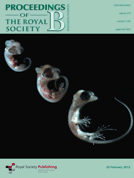人们普遍认为,恐龙的身躯如此庞大,是因为自然选择偏爱体型大的物种。但一项新的研究却对这种认识提出质疑。相关研究发表在Proceedings of the Royal Society期刊上。
科学家们测量了物种存续时间超过一亿年的恐龙化石,发现这些数据并不符合“科普法则”(Cope'srule)。科普法则认为,在地史时期里,一个物种或谱系中的个体,体型总会变得越来越大,这是自然选择所造就的。因此,物种内部体型最大和最小值都会随着时间而增大。然而该研究所涉及的恐龙化石却没能呈现这种规律。“虽然从整体上看,恐龙体型最大值的确随着时间有明显增大,但从细节上来讲,每一个线系的体型变化都有复杂的规律,既有增加,又有减少。”研究的参与者,德国慕尼黑大学的古生物学家R.Butler说。“多年以来恐龙都是科普法则的重要例证。我们的研究认为恐龙体型的演化其实并非如此简单。”

兽孔类空出的生态位迅速被庞大的恐龙占领
之前学界有人提出,恐龙的食物可能与体型增大有重要关系。例如,四足长颈的蜥脚类恐龙取食苏铁和针叶树,可是这些食物难以消化,蜥脚类恐龙的牙齿结构简单,不适于咀嚼。因此,它们吞下几乎未经咀嚼的食物,由强大的胃承担消化任务。
虽然蜥脚类恐龙的砂囊就能将食物粉碎,但植物细胞中的养分必须通过化学作用获取,因此恐龙就需要一个很大的胃来降解食物碎屑。这样一来,身宽体胖的大胃王们就拥有了进化优势。
另一种理论认为,恐龙活动量很小,当食物丰富的时候,它们体内过剩的供能物质如糖类等转而参与了身体的增长。但该理论只有在恐龙是冷血的前提下才成立,因为若恐龙是温血,将需要很多能量维持体温,没有多余能量增大体型了。
庞大的身躯能躲开普通的捕食者,但并非所有恐龙都采取这一策略。例如,娇小的身材更适合飞行,同样可逃脱捕食者的追逐。
本文提到的新研究使用了共400例初龙型类(包括恐龙)、兽孔目(哺乳动物的祖先)动物的化石,测量它们的股骨长度并以此估计体重。这些数据所展示的规律和多种演化模型都不符合,其中也包括科普法则。
当进化谱系被纳入考量范围时,科普法则中的现象就很少出现了。兽孔类灭绝后,地球上才渐渐出现身形硕大的恐龙。“恐龙起初并不庞大,它们体型的增长并不是由于越大越好。相反,独特的生理条件使它们有更多增加体型的潜力。”Butler说。
这种独特的生理条件包括巨大的肺容量、惊人的生长速率等。Butler的研究认为,在一些巨大的兽孔类动物灭绝之后,体型较小的恐龙才有机会进驻它们曾经占据的生态位,幸运的是恐龙有能力迅速增加自己的体型,便最终成了陆地的主人。因此,恐龙的成功除了演化上占据优势,更来自幸运之神的眷顾。
这些研究再次证明,谱系中多个类群的演化趋势是十分复杂的。Butler打算回顾恐龙家族的整个演化历史,到那时,我们就能对生物灭绝事件中物种的演化规律作出预测了。

Rise of dinosaurs reveals major body-size transitions are driven by passive processes of trait evolution
Roland B. Sookias, Richard J. Butler and Roger B. J. Benson
A major macroevolutionary question concerns how long-term patterns of body-size evolution are underpinned by smaller scale processes along lineages. One outstanding long-term transition is the replacement of basal therapsids (stem-group mammals) by archosauromorphs, including dinosaurs, as the dominant large-bodied terrestrial fauna during the Triassic (approx. 252–201 million years ago). This landmark event preceded more than 150 million years of archosauromorph dominance. We analyse a new body-size dataset of more than 400 therapsid and archosauromorph species spanning the Late Permian–Middle Jurassic. Maximum-likelihood analyses indicate that Cope's rule (an active within-lineage trend of body-size increase) is extremely rare, despite conspicuous patterns of body-size turnover, and contrary to proposals that Cope's rule is central to vertebrate evolution. Instead, passive processes predominate in taxonomically and ecomorphologically more inclusive clades, with stasis common in less inclusive clades. Body-size limits are clade-dependent, suggesting intrinsic, biological factors are more important than the external environment. This clade-dependence is exemplified by maximum size of Middle–early Late Triassic archosauromorph predators exceeding that of contemporary herbivores, breaking a widely-accepted ‘rule’ that herbivore maximum size greatly exceeds carnivore maximum size. Archosauromorph and dinosaur dominance occurred via opportunistic replacement of therapsids following extinction, but were facilitated by higher archosauromorph growth rates.
文献链接:








